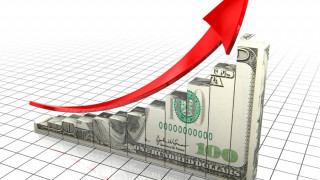The four-year electoral cycle of the Georgian Dream coalition’s office is coming to its end and it is interesting to observe the changes in the Georgian economy for the past four years. We will assess the changes in the economy by analysing major macroeconomic indicators.
Gross Domestic Product (GDP) and Economic Growth
The Georgian economy in 2012 (GDP) was USD 15.8 billion whilst the forecast GDP for 2016 (government forecast) is USD 14.3 billion. The decrease in GDP in USD was due to the depreciation of GEL. If we look at the nominal GDP in GEL, it equalled GEL 26.2 billion in 2012 whilst it will amount to GEL 34.2 billion in 2016. Inflation, or the increase in prices for goods and services, has played its role in the growth of the GDP in GEL. Without the influence of inflation, Georgia’s real GDP has increased by GEL 3.4 billion for the past four years. According to the 2012 Georgian Dream coalition government’s forecast, Georgia’s GDP would be over GEL 40 billion by 2016 whilst in reality it has reached only GEL 34.2 billion.
Despite the fact that Georgia’s GDP in GEL has increased, the growth rate of the GDP for the past four years has significantly decreased. If from 2010 to 2012 Georgia’s GDP had an average growth rate of 6.6%, the average growth rate from 2013 to 2015 dropped to 3.4%. It should also be noted that the government was failing to achieve the GDP’s forecast growth rate every year from 2013 to 2015.
Chart 1: Georgia’s GDP and Economic Growth Rate
As for the GDP per capita, it equalled USD 3,523 in 2012 whilst it will reach USD 3,820 in 2016. The growth of the GDP per capita in USD is due to the fact that calculations were made in 2016 according to the results of the new population census which determined that Georgia’s population is 3.7 million people. The International Monetary Fund has already corrected the data vis-à-vis Georgia’s population for the past years and found that the country’s GDP per capita in 2012 was USD 3,837. Hence, it is evident that this indicator will be lower in 2016 than it was in 2012. This decrease is due to the depreciation of GEL. If we look at the 2016 GDP per capita of Georgia in GEL, it has increased by GEL 3,350 as compared to 2012.
Inflation (Prices of Goods and Services)
Inflation in 2012 (according to the Consumer Price Index) was 1.4% which meant that goods and services became less expensive. Inflation equalled 2.4% in 2013, 2% in 2014 and 4.9% in 2015. A maximum of 5% inflation is expected to take place in 2016.
Consumer goods and services have become more expensive by about 10% over the last four years. The prices of alcoholic beverages and tobacco increased the most, by 38%. Healthcare holds the second place with a 22% price increase. The third place is occupied by hotels and restaurants with a 19% increase. Groceries are in the next place, becoming 13% more expensive. Only two types of goods have become less expensive: clothing (-12%) and transport (-10%) due to the drop in fuel prices.
GEL Exchange Rate
The GEL exchange rate was one of the most spoken about issues for the past four years. The GEL exchange rate with regard to USD was 1.66 in October 2012. The first signs of depreciation were already apparent by the end of 2013 when the exchange rate increased to 1.74. The exchange rate remained the same until the end of 2015; however, it started depreciating rapidly at the end of the year. Despite the fact that the National Bank of Georgia sold USD 427 million to stabilise the situation, the GEL exchange rate with regard to USD reached 2.5 at the beginning of 2016. The national currency started strengthening from spring 2016 and the process continued until August 2016. GEL started to depreciate once again from the end of August and the exchange rate with regard to USD reached 2.35. In total, as compared to October 2012, the exchange rate of GEL depreciated by 42%.
Unemployment
According to the official data of the National Statistics Office of Georgia, the level of unemployment in Georgia (the share of unemployed people in the labour force over the age of 15) decreased in the period from 2013 to 2015. The level of unemployment in 2012 was 15% whilst it had gone down to 12% by 2015. However, the greatest reason for doubting unemployment statistics is that the labour force (the able bodied population over the age of 15) decreased in size only slightly after the new population census.
As for employment, we have the following picture: a total of 1,724 thousand people were considered to be employed in 2012 whilst this number had increased to 1,780 thousand by 2015 with only 56,000 additional people employed.
Government Debt
By the end of 2012, the external debt of the Government of Georgia was GEL 6.6 billion (USD 4 billion), about 25.3% of the GDP, whilst the domestic debt equalled GEL 1.9 billion, or 7.2% of the GDP. In total, the government debt was GEL 8.5 billion and 32.5% of the GDP. According to the data of August 2016, the government’s external debt reached GEL 10.2 billion (USD 4.4 billion) whilst domestic debt equalled GEL 3.3 billion. Overall, government debt in 2016 is almost GEL 13.6 billion which is 41% of the GDP. The growth of the external debt was mainly due to the depreciation of the GEL exchange rate whilst the domestic debt increased because of the taking of an additional GEL 1.4 billion in loans.
Foreign Investments
Foreign direct investments increased in the period from 2013 to 2016 as compared to 2012. A total of USD 912 million was invested in Georgia in 2012 with this figure increasing to USD 942 million in 2013, USD 1,758 in 2014 and USD 1,565 in 2015. A total of USD 834 million has been invested in Georgia in the first two quarters of 2016.
The amount of investments increased significantly in fields such as the mining industry, construction, hotels and restaurants as well as transportation. The largest growth was observed in the field of transportation which is connected to the Shah-Deniz 2 pipeline. About USD 1 billion has been invested in Georgia in terms of this project.
Summary
Based upon the main macroeconomic indicators we can say that there is progress in certain fields; however, it should also be noted that serious problems have been revealed in terms of economic growth, the GEL exchange rate and the government debt. First and foremost, it should be pointed out that the growth rate of the Georgian economy and, consequently, the rate of the country’s development have decreased. Despite the decrease in the economy’s growth rate, the government kept significantly increasing budget spending which resulted in the growth of the government debt. The severe economic conditions in the region (Russia, Ukraine and Azerbaijan) had a serious negative influence on the Georgian economy as well, especially so in terms of exports and money transfers from foreign countries. As a result, domestic problems were complemented with external problems which best manifested itself in the GEL exchange rate. The national currency’s exchange rate is also the reason for the growth of the government debt denominated in GEL. Even though the growth of investments partially balanced the negative trends and ensured a 3% growth of the Georgian economy, it should be pointed out that the Georgian Dream coalition government had much more ambitious plans at the end of 2012 than the results we have today.








